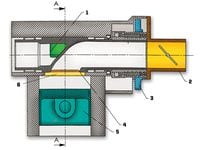Motorcyclist reader Patrick Hunt emailed recently asking about the Coates rotary-valve engine. Back in the 1990s, an interested firm asked for my opinion about the Coates valve system. Readers can easily learn how the Coates system works on their own, so I won’t go into great detail here. My research found that Coates rotary valves, which are roughly the same diameter as the cylinder bore, necessitate a combustion chamber shape very similar to what used to be called a “hemispherical” chamber with conventional valves splayed about 30 degrees from the cylinder axis. Modern valve angles are typically 15 degrees or less, and piston crowns are flat or very close to it. The Coates arrangement, by comparison, has a domed top, and its valves leave short “port remnants” when closed, creating isolated areas in the chamber where combustion is likely to be incomplete—bad news for both emissions and efficiency. My conclusion was that the Coates system couldn’t compete effectively with more modern, conventional valve technology.
So I thought I knew everything about rotary valves, but Hunt’s email encouraged me to revisit the topic and see if there were any new developments in the past two decades. I had no idea I’d find something remarkable.
A special motorsports issue of AutoTechnology magazine from 2007 included an article by Tony Wallis detailing rotary valve system developed by Bishop Innovation in conjunction with Ilmor Engineering for use in Formula 1. Bishop began the project in 1997, and by 2000 its single-cylinder test engines surpassed conventional F1 test engines in both power and durability. Complete V-10 engines were built and successfully tested next, and by 2003 the program looked set for an F1 debut. Then, in 2004, the FIA announced rule changes banning rotary valve technology completely.
Unlike the two-valve Coates design, the Bishop Rotary Valve (BRV) system uses a single cylindrical valve for both intake and exhaust functions. This is how the Bishop rotary valve works (numbers refer to the figure above): The valve sits directly above the cylinder, perpendicular to the crankshaft. A rectangular “window” (6) above the piston (5) matches up with similar windows in the intake (4) and exhaust (1) sections of the valve as the valve rotates to alternately align the windows or seal the cylinder.
A gear (3) fixed to the intake end of the valve is turned by a gear train off the crankshaft so that the valve rotates at half crank speed. In multi-cylinder engines, the valves of adjacent cylinders are geared together with one valve gear meshing directly with the next. Some versions provide for variable valve timing, though intake and exhaust timing can’t be independently changed. Sealing strips flanking the four sides of the window provide cylinder sealing by pressing against the rotating valve body. This drawing shows a separate, non-rotating throttle body (2), but in the V-10 version, the valves all feed from a central airbox.
What are the benefits? The rotary-valve V-10 engine exhibited a 10-percent power improvement, while weight was reduced by about 3.5 pounds per cylinder. The engine’s physical size was also reduced, with the cylinder heads a full 50mm shorter than conventional heads. By casting the “window” into the block rather than the head, a head gasket and large cylinder head bolts were not required.
Think about this technology in a motorcycle: A typical four-cylinder engine might be 13 pounds lighter and almost 3 liters smaller in volume—a huge packaging advantage in these days when every bit of space is filled. And 10-percent more power? What’s not to like?
Unfortunately, this technology has seemingly disappeared since being banned in Formula 1. Where is it now? Is this just ancient engineering history or something that we might see in the future? It’s the most intriguing engine technology I’ve seen in a long time, and I intend to continue researching, trying to find out if the rule change really sunk this fascinating creative effort. Let’s hope it didn’t.












/cloudfront-us-east-1.images.arcpublishing.com/octane/S35YGSEMEZB4BLTDJTSZPF4GLA.jpg)
/cloudfront-us-east-1.images.arcpublishing.com/octane/5UOT6HPX2JFMRJAX6EH45AR4MQ.jpg)
/cloudfront-us-east-1.images.arcpublishing.com/octane/OKWOJWAKP5EP3OACCRRWPCIX2Q.jpg)
/cloudfront-us-east-1.images.arcpublishing.com/octane/2WF3SCE3NFBQXLDNJM7KMXA45E.jpg)
/cloudfront-us-east-1.images.arcpublishing.com/octane/G4MG6OUCJNBSHIS2MVVOTPX65E.jpg)
/cloudfront-us-east-1.images.arcpublishing.com/octane/IIGGWFOTOJGB7DB6DGBXCCMTDY.jpg)
/cloudfront-us-east-1.images.arcpublishing.com/octane/QSTCM6AVEZA5JJBUXNIQ3DSOF4.jpg)
/cloudfront-us-east-1.images.arcpublishing.com/octane/U4I7G625B5DMLF2DVIJDFZVV6M.jpg)
/cloudfront-us-east-1.images.arcpublishing.com/octane/B6XD6LS6IVCQPIU6HXDJSM3FHY.jpg)
/cloudfront-us-east-1.images.arcpublishing.com/octane/ICL63FEDDRDTTMINYICCEYGMDA.jpg)
/cloudfront-us-east-1.images.arcpublishing.com/octane/FCGZHQXRBZFLBAPC5SDIQLVF4I.jpg)
/cloudfront-us-east-1.images.arcpublishing.com/octane/WNOB6LDOIFFHJKPSVIWDYUGOPM.jpg)

/cloudfront-us-east-1.images.arcpublishing.com/octane/X33NU3E525ECRHXLNUJN2FTRKI.jpg)
/cloudfront-us-east-1.images.arcpublishing.com/octane/6KKT5NNL2JAVBOXMZYS5ZO76YA.jpg)
/cloudfront-us-east-1.images.arcpublishing.com/octane/J5RKG5O455GMPGQRF2OG6LRT7A.jpg)
/cloudfront-us-east-1.images.arcpublishing.com/octane/GX2CIZKQVRH2TATDM26KFG2DAE.jpg)
/cloudfront-us-east-1.images.arcpublishing.com/octane/ZWIDYSAKQZHD5BHREMQILXJCGM.jpg)
/cloudfront-us-east-1.images.arcpublishing.com/octane/CYUHJZCTSJCH3MRAQEIKXK7SCQ.jpg)
/cloudfront-us-east-1.images.arcpublishing.com/octane/LKOFINY56FCXJCANJ5M7ZDQUBY.jpg)
/cloudfront-us-east-1.images.arcpublishing.com/octane/4NBPDACMWJH63JQYJVK3QRBDZI.jpg)
/cloudfront-us-east-1.images.arcpublishing.com/octane/KKHQHRR3FJGX7H2IPU6RALMWG4.jpg)

/cloudfront-us-east-1.images.arcpublishing.com/octane/5IOFS5JAE5FOXMNA23ZRAVVYUU.jpg)